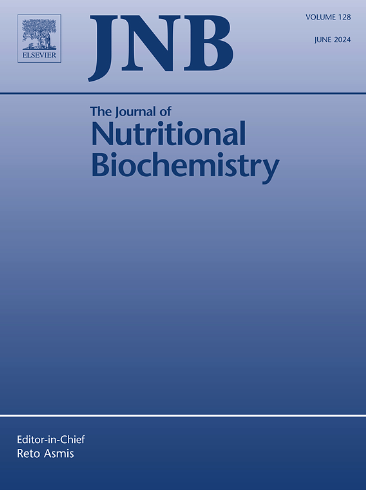In vivo metabolic effects of naringin in reducing oxidative stress and protecting the vascular endothelium in dyslipidemic mice
IF 4.8
2区 医学
Q1 BIOCHEMISTRY & MOLECULAR BIOLOGY
引用次数: 0
Abstract
Naringin, a flavonoid, has high antioxidant activity and hypolipidemic pharmacological effects. In this study, an animal model of dyslipidemia was established by feeding Apoe-/- mice a high-fat diet for 4 weeks. Subsequently, the mice were administered Naringin via gavage at doses of 50 mg/(kg·d), 100 mg/(kg·d), or 200 mg/(kg·d) for an additional 4 weeks. The research utilized liquid chromatography–mass spectrometry (LC–MS) metabolomics in conjunction with analyses of serum oxidative stress markers, Hematoxylin-eosin staining, Masson's trichome staining, and immunohistochemical staining. Naringin treatment reduced serum total cholesterol, triglycerides, and low-density lipoprotein cholesterol concentrations (P<.05), reversed disorders of vascular structure and morphology, increased serum nicotinamide adenine dinucleotide phosphate hydride and glutathione concentrations (P<.05), reduced serum peroxynitrite concentrations (P<.05), promoted aortic endothelial nitric oxide synthase protein expression and inhibited aortic prolyl isomerase-1 protein expression. Twenty differentiated metabolites were obtained from the serum by LC–MS assay, followed by 16 differential metabolic pathways after enrichment. Among the metabolic pathways, glycolysis/gluconeogenesis, the pentose phosphate pathway, purine metabolism, ascorbate metabolism, and aldarate metabolism are the most relevant metabolic pathways by which naringin reduces oxidative stress. Our findings suggest that naringin can reduce oxidative stress levels associated with dyslipidemia through multiple metabolic pathways, protect vascular endothelial function, and thus providing a novel and promising natural medicine for treating dyslipidemia.

柚皮素是一种黄酮类化合物,具有很高的抗氧化活性和降血脂药理作用。本研究通过给载脂蛋白/-小鼠喂食高脂食物 4 周,建立了血脂异常动物模型。随后,以 50 毫克/(千克-日)、100 毫克/(千克-日)或 200 毫克/(千克-日)的剂量给小鼠灌胃服用柚皮苷达 4 周之久。研究采用了液相色谱-质谱(LC-MS)代谢组学方法,并结合血清氧化应激标记物、苏木精-伊红染色、马森氏毛状体染色和免疫组化染色进行了分析。柚皮苷能降低血清总胆固醇、甘油三酯和低密度脂蛋白胆固醇的浓度(P
本文章由计算机程序翻译,如有差异,请以英文原文为准。
求助全文
约1分钟内获得全文
求助全文
来源期刊

Journal of Nutritional Biochemistry
医学-生化与分子生物学
CiteScore
9.50
自引率
3.60%
发文量
237
审稿时长
68 days
期刊介绍:
Devoted to advancements in nutritional sciences, The Journal of Nutritional Biochemistry presents experimental nutrition research as it relates to: biochemistry, molecular biology, toxicology, or physiology.
Rigorous reviews by an international editorial board of distinguished scientists ensure publication of the most current and key research being conducted in nutrition at the cellular, animal and human level. In addition to its monthly features of critical reviews and research articles, The Journal of Nutritional Biochemistry also periodically publishes emerging issues, experimental methods, and other types of articles.
 求助内容:
求助内容: 应助结果提醒方式:
应助结果提醒方式:


